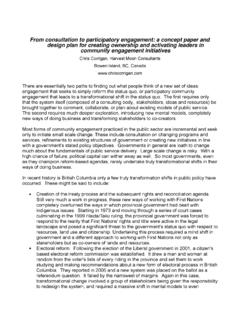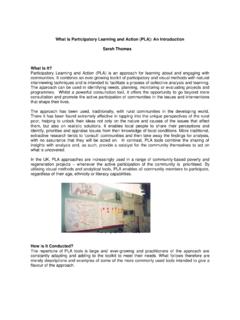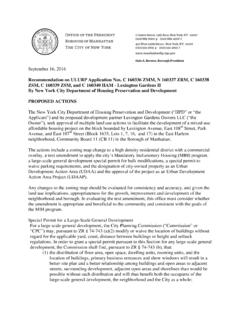Transcription of THE FOURTH PILLAR Culture’s essential role - CDN
1 THE FOURTH PILLAR . OF SUSTAINABILITY. culture 's essential role in public planning BY J ON HAWKES. F OR T HE CULT U R A L. DEVELOPMEN T NET WORK. VICTORIA. i This book is published at the a series imprint of the First published in Australian in 2001 by Common Ground Publishing Pty Ltd in association with the Cultural Development Network (Vic). Copyright Jon Hawkes and the Cultural Development Network (Vic) 2001. All rights reserved. Apart from fair dealing for the purposes of study, research, criticism or review as permitted under the Copyright Act, no part of this book may be reproduced by any process without written permission from the publisher. National Library of Australia Cataloguing-in-Publication data: Hawkes, Jon, 1946- . The FOURTH PILLAR of sustainability: culture 's essential role in public planning. Bibliography. ISBN 1 86335 049 7. ISBN 1 86335 050 0 (PDF). 1. Social policy. 2. Arts and society. 3. Cultural policy. I. Cultural Development Network of Victoria.
2 II. Title. Cover and text designed by Dianna Wells Design Printed in Australia by dbooks on recycled paper. The Cultural Development Network is supported by: Contact Details: Judy Spokes, Executive Officer Cultural Development Network (Vic). ii FOREWORD. culture is one of those omnibus terms like democracy or environment which embraces many different usages employed by many different people for many different purposes. It thus defies precise definition. It can be seen to represent very many of the intangible aspects of our values, customs and patterns of life that are often ignored in government thinking and action. If the understanding or definition is a broad one, it represents profoundly important aspects of any society. There is therefore a critical need to reintroduce the notion of culture into the language of politicians and bureaucrats. This is what Jon Hawkes has set out to do in this paper. The paper explores the many different ways that culture affects and relates to patterns of human activities and policy realms.
3 It concludes with a discussion of the practical ways in which notions of culture can be applied to public policy and examples of models that can be drawn upon from around the world. The notion of cultural policy is a largely a foreign one in Anglo-Celtic countries. There are certainly arts policies and no one would belittle their importance. Arts policies should have an honoured place in any cultural policy. But a cultural policy, or a cultural framework as Jon Hawkes prefers to argue, should seek to do more. Its aim should be to enrich the lives of all citizens in many different ways and to protect and enhance the rights of citizens to freedom of expression and access to information and resources. It should therefore begin with a set of principles or objectives which are widely available for discussion. Jon Hawkes lists the objectives for cultural policy in Sweden as an example. These and other alternatives discussed provide an excellent foundation for the development of objectives or principles relevant to Australia.
4 Once a set of principles has been agreed, the next step is to determine the policy areas to which a particular cultural policy will apply. This is important because there are many options, some which spill over into social or environmental policy. The choice of policy areas should be pragmatic but also needs to be fully justified. Jon opts for a framework or sieve applicable to all areas of public policy rather than for the development of a specific cultural policy. I would argue for both. Whatever the merits of either argument, there is scope and material enough in this paper to stimulate a good debate within any government body about the best way to proceed. The last step is to apply the agreed principles to the chosen policy areas to determine what new policies or reinforcement or modification of existing policies might be proposed. In these different ways, the ideas which Jon Hawkes is canvassing and the debate which he is opening up can be turned to practical advantage.
5 I commend the paper to you and hope that it will lead to much new thinking and policy innovation. D AVID YENCKEN. iii CONTENTS. Preface vi Summary vi Introduction 1. CHAPTER 1 The meaning of culture 3. Establishing a useful description 3. culture in everyday useage 4. Values 4. culture and government 7. Developments in the public planning arena 9. CHAPTER 2 The application of culture 11. Sustainable development 11. Wellbeing 12. Diversity 13. Globalisation and distinctiveness 15. Engagement, active citizenship and civil society 16. Creativity and innovation 17. Community building, cohesion, capacity and social capital 18. Liveability and quality of life 19. Identity and character 19. Belonging and a sense of place 20. Ethics and morality 21. Progress and development 21. Vitality 22. The arts 23. Ecologically sustainable development and the triple bottom line 25. CHAPTER 3 The results of culture 27. Restructuring 27. Education and training 28.
6 Communications and public affairs 29. The constructed environment and public facilities 30. Arts 30. History and heritage 30. Recreation and leisure 31. Sport 31. iv A Cultural Framework' 32. Cultural indicators 33. Content 33. Practice 33. Results 33. Specific policy development 34. Instrumental initiatives 37. Cultural action 37. Conclusion 38. Appendix 1: Public planning frameworks 39. Citizenship and deliberative democracy 39. Community capacity building 40. Community indicators 40. Ecologically Sustainable Development and Local Agenda 21 40. Genuine Progress Indicator 42. Good practice 43. Integrated local area planning (ILAP) 43. Quality of life, wellbeing, life satisfaction & liveability 43. Subjective indicators 44. Objective indicators 44. Social auditing 46. Social capital 46. Sustainable development 47. Sustainable development indicators (SDIs) 47. Triple bottom line 47. Whole of government 47. Appendix 2: The Action Plan from The Power of culture ' 48.
7 Preamble 48. Recognizes the following principles 49. The Conference in consequence affirms that 49. Policy objectives recommended to member states 51. 1: To make cultural policy one of the key components of development strategy. 51. 2: Promote creativity and participation in cultural life. 52. v 3: Reinforce policy and practice to safeguard and enhance the cultural heritage, tangible and intangible, moveable and immoveable, and to promote cultural industries. 52. 4: Promote cultural and linguistic diversity in and for the information society. 54. 5: Make more human and finacial resources available for cultural development. Recommendations to the Director-General of UNESCO 55. Appendix 3: Arts indicators 57. The arts community's connections to larger community issues and expectations 57. Community perceptions of the arts 57. Community expectations of the arts community 57. Connections across groups/boundaries 58. Diversity of opportunities for arts participation, including opportunities for continuous and deepening participation 58.
8 Diversity of opportunities for youth and level and continuity of participation by youth 58. The arts community's response to cultural diversity 58. Vitality of arts offerings 59. Health of the arts community 59. Opportunities for vocational arts training 59. Diversity of institutions involved in the arts, including non-traditional examples 59. Arts community's engagement with celebration of heritage 60. Sustainability of the arts community 60. Municipal contribution 60. Appendix 4: About the author and the Network 61. The author 61. The Cultural Development Network (Vic) 61. Bibliography 62. vi P R E FA C E. This paper has been prepared for the Cultural Development Network (Vic). The brief under which it was commissioned called for the examination of the potential value of a specifically cultural perspective to the planning, service delivery and evaluation activities of local government. The title of this monograph is inspired by Yencken and Wilkinson who, in their book, Resetting the Compass (2000), support those asserting that there should be four pillars of sustainability.
9 S U M M A RY. A society's values are the basis upon which all else is built. These values and the ways they are expressed are a society's culture . The way a society governs itself cannot be fully democratic without there being clear avenues for the expression of community values, and unless these expressions directly affect the directions society takes. These processes are culture at work. Cultural vitality is as essential to a healthy and sustainable society as social equity, environmental responsibility and economic viability. In order for public planning to be more effective, its methodology should include an integrated framework of cultural evaluation along similar lines to those being developed for social, environmental and economic impact assessment. vii INTRODUCTION. There is a growing recognition among those who influence the way our society manages itself that economic benchmarks alone are an insufficient framework upon which to evaluate progress or to plan for the future.
10 This awareness has led to the development (and rediscovery) of a wide range of alternative ways of viewing and analysing the performance of a society1. All these new frameworks are based on a commitment to expanding the consciousness of what makes for a society that reflects and fulfils the aspirations of its citizens. This paper will demonstrate that the concept of culture is an invaluable tool that has been largely ignored in these attempts to reconfigure the ways that governments plan the future and evaluate the past. When culture is taken to denote the social production and transmission of values and meaning 2 and it is recognised that the expression of social purpose and aspiration is at the heart of the public planning process3, then the connection between culture and planning becomes clearer. So also does the potential for the use of culture as a core element in the mechanisms that facilitate effective public planning. The introduction of the concept of culture into the theoretical and operational frameworks of public affairs has an extraordinary range of potential benefits.








